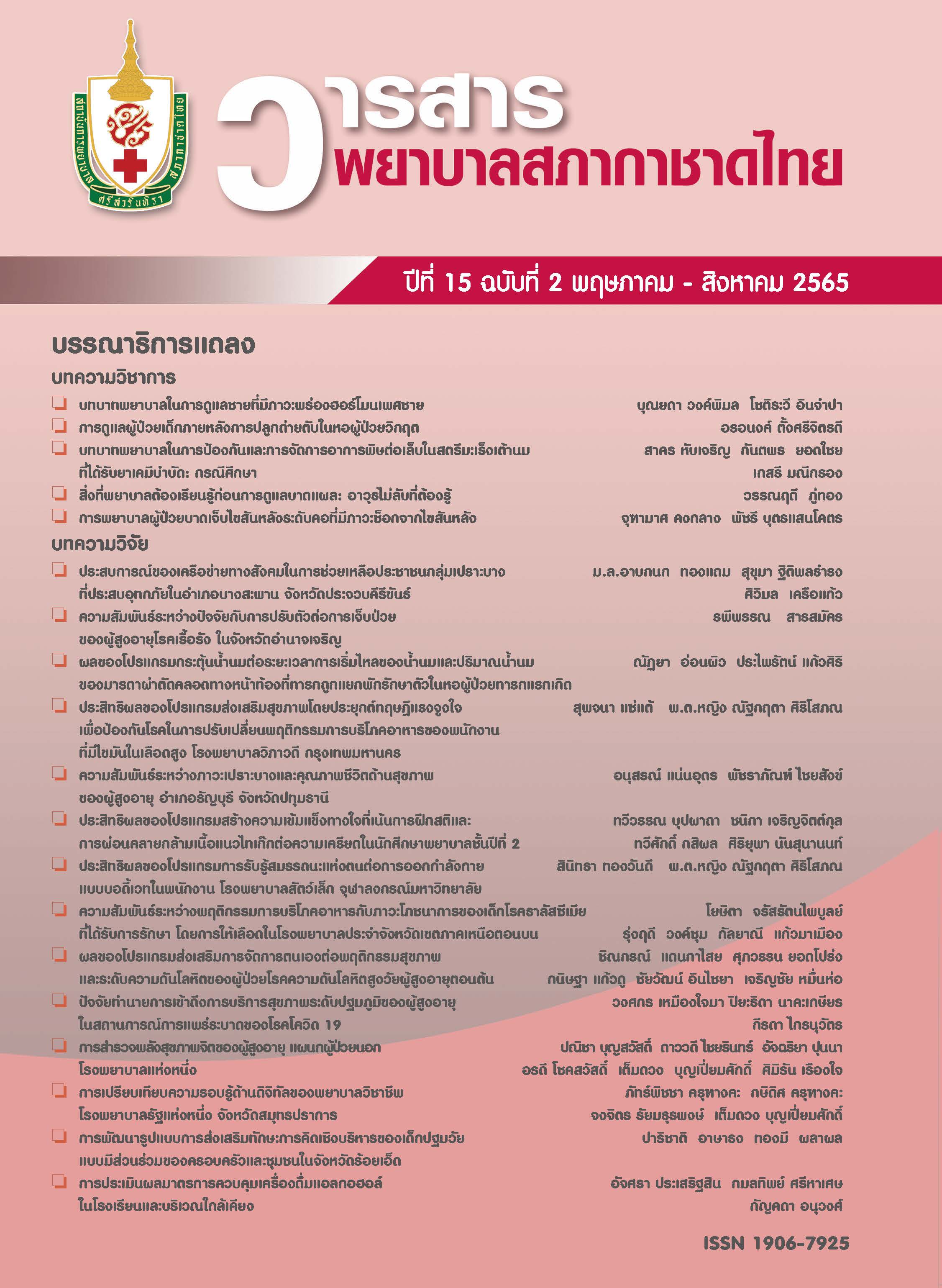What Nurses Need to Learn Before Caring for Wounds: The Weapon Doesn’t Secretly Need to Know
Keywords:
anatomy and pathosphysiology of skin , wounds, wound healing process, wound closure, classification of wounds, nursing roles for wound healingAbstract
Currently, wounds remain a challenging clinical problem with complications from acute, chronic, and complicated wounds. Wounds and skin disorders have had a huge impact on the global population as well as the physio-psychological wellbeing of the patients. This is a crisis for health teams, especially for the nurses who care for the wounds. The more it is necessary to reduce the severity of the wound, the greater the effort must be made to focus on understanding the physiological aspects of wound healing, the pathogenesis of chronic wounds, and cognition of their structure. The functioning of the skin and wound healing process is important, so nurses must focus on the role of proper wound management for wound healing.
References
Laochai S. A study of knowledge and skills to dressing properly before professional experience of community public health students [Thesis]. Maha Sarakham: Rajabhat Maha Sarakham University; 2017. (in Thai).
Langemo DK, Melland H, Hanson D, Olson B, Hunter S. The lived experience of having a pressure ulcer: a qualitative analysis. Adv Skin Wound Care 2000;13(5): 225-35.
Li Z, Lin F, Thalib L, Chaboyer W. Global prevalence, and incidence of pressure injuries in Hospitalized adult patients: a systematic review and meta-analysis. Int J Nurs Stud 2020;105:103546. doi: 10.1016/j.ijnurstu.2020.103546.
Brem H, Stojadinovic O, Diegelmann RF, Entero H, Lee B, Pastar I, et al. Molecular markers in patients with chronic wounds to guide surgical debridement. Mol Med 2007;13(1-2):30-9.
Buasrisai N. Factors associated with the ability to care for open wounds of professional nurses [Thesis]. Chonburi: Burapha University; 2012. (in Thai).
Thompson P, Langemo D, Anderson J, Hanson D, Hunter S. Skin care protocols for pressure ulcers and incontinence in long-term care: a quasi-experimental study. Adv Skin Wound Care 2005;18(8):422-9.
Buasrisai N. Factors related to open wound care abilities of surgical Nurses in The Lower Central Region Hospitals [Thesis]. Chonburi: Burapha University; 2012. (in Thai).
Whitty JA, McInnes E, Bucknall T, Webster J, Gillespie BM, Banks M, et al. The cost-effectiveness of a patient centred pressure ulcer prevention care bundle: findings from the INTACT cluster randomised trial. Int J Nurs Stud 2017;75:35-42.
Etafa W, Argaw Z, Gemechu E, Melese B. Nurses’ attitude and perceived barriers to pressure ulcer prevention. BMC Nurs 2018;17:14. https://doi.org/10.1186/s12912- 018-0282-2
Matthew H. Picture of the skin: human anatomy [Internet]. 2014 [cited 2021 Dec 1]. Available from: https://www.webmd.com/skin-problems-and-treatments/picture-of-theskin
White P. Structure and function of the skin [Internet]. 2019 [cited 2019 Oct 28]. Available from: https://www.clinimed.co.uk/wound-care/wound-essentials/structure-andfunction-of-the-skin
Farris PK. Skin anatomy and physiology [Internet]. 2014 [cited 2021 Dec 1]. Available from: https://www.nuskin.com/en_ZA/corporate/company/science/skin_care_ science/skin_anatomy_andphysiology.html
Baranoski S, Ayello EA. Wound care essentials: practice principles. 4th ed. Philadelphia: Wolters Kluwer; 2016.
Dealey C. The care of wounds: a guide for nurses. 4th ed. Chichester, West Sussex: Wiley-Blackwell; 2012.
Craven RF, Hirnle CJ, Henshaw CM. Fundamentals of nursing: concepts and competencies for practice. 9th ed. Philadelphia: Wolters Kluwer; 2021.
Hess CT. Clinical guide to skin & wound care. 7th ed. Philadelphia: Wolters Kluwer Health/Lippincott Williams & Wilkins; 2013.
Baranoski S, Ayello EA. Wound care essentials: practice principles. 4th ed. Philadelphia: Wolters Kluwer; 2016.
Phuthong W. Care of elderly patients with chronic wounds. In: Chinuntuya P, editor. Academic articles of continuing education in nursing, Volume 12. Wound Care. Nonthaburi: Nursing Council; 2012. p. 103-12. (in Thai).
Chairat C. Emergency wound management [Documents describing nursing Courses specialized in emergency nursing]. Bangkok: Boromarajonani College of Nursing; 2013.
Perez E, Foley M, Karlin R. Classification of burns [Internet]. 2021 [cited 2021 Dec 1]. Available from:https://www.urmc.rochester.edu/encyclopedia/content.aspx?ID= Conten tType90&ContentID=P0 9575
National Pressure Ulcer Advisory Panel, European Pressure Ulcer Advisory Panel and Pan Pacific Pressure Injury Alliance. Prevention and treatment of pressure ulcers: clinical practice guideline. Cambridge Media: Osborne Park, Western Australia; 2014.
Centers for Medicare & Medicaid Services. Nursing home quality initiatives: MDS 3.0 overview [Internet]. 2014 [cited 2021 Dec 1]. Available from: http://www.cms.hhs.gov/ NursingHomeQualityInits/01_Overview.asp# Top0fPage
Faller NA. The yellow-red-black bladder diary: red-yellow-black is not just for wounds. Ostomy Wound Manage 2009;55(12):26-32.
Taylor C, Lynn P, Bartlett JL. Fundamentals of nursing: the art and science of person-centered nursing care. 9th ed. Philadelphia: Wolters Kluwer; 2019.
John M. How wounds heal: the 4 main phases of wound healing [Internet]. 2015 [cited 2021 Dec 1]. Available from: http://www.shieldhealthcare.com/community/ popular/2015/12/18/how-wounds-heal-the-4-main-phases-of-wound-healing/
Downloads
Published
Issue
Section
License
Copyright (c) 2022 Srisavarindhira Thai Red Cross Institute of Nursing

This work is licensed under a Creative Commons Attribution-NonCommercial-NoDerivatives 4.0 International License.
เนื้อหาบทความหรือข้อคิดเห็นต่างๆ ในวารสารพยาบาลสภากาชาดไทยนี้ เป็นความคิดเห็นของผู้เขียนบทความ ไม่ใช่ความเห็นของกองบรรณาธิการ หรือสถาบันการพยาบาลศรีสวรินทิรา สภากาชาดไทย






